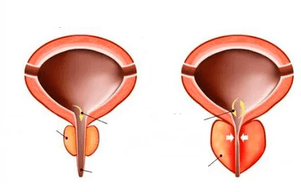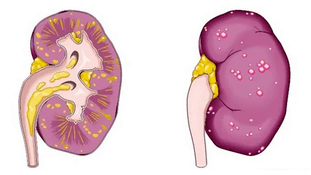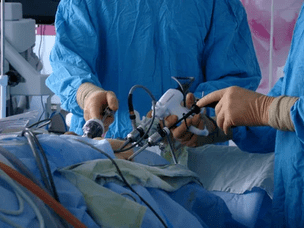
Many doctors jokingly call prostatitis male menopause. The disease is diagnosed in 20% of men after forty years, in 70% - in sixty years and in 90% after seventy years. The disease can take two forms: acute and chronic prostatitis. This disease should be treated, especially if it has a good effect on self-therapy. However, many men ignore the unpleasant symptoms, which leads to the development of many complications that are more difficult to treat.
developmental reasons
Acute prostatitis is an acute pathology of the prostate that develops as a result of an inflammatory and infectious process in an organ due to the penetration of pathogens into the tissues. The disease is characterized by swelling of the pancreas, the presence of purulent content in the tissues.It causes many unpleasant symptoms, disorders of the genitourinary system.
There are many causes of acute prostatitis. In most cases,is triggered by pathogenic microbes.Some germs can be passively present in the skin or intestines of a healthy person. Under the influence of some factors, they become active, penetrate the glandular tissues and actively multiply there. The disease is often caused by STDs, such as chlamydia, ureaplasmosis, gonorrhea, and so on.
In addition, an acute form of prostatitis occurs as a complication ofurethritis. Germs enter the urethra through ducts. In addition, the spread of bacteria from other organs of the genitourinary system often leads to the appearance of prostatitis. Often, the cloth can be affectedDuring surgical procedures, catheterization, diagnostic procedures.
Because the prostate gland has a large number of blood vessels, the infection can come here through the bloodstream when there are chronic pathologies in the body, such astonsillitis, bronchitisand so on.In the presence ofanal fissuresgerms can enter the prostate through the lymph flow.
However, infections do not always lead to the development of the disease. In the veins of the pelvic region, a blockage that developswith prolonged abstinence from sex, or most of them.
Obstructionis also associated with lack of physical activity, constant constipation, alcoholism, varicose veins in the pelvic region, hypothermia.
Classification
There are several pathological forms in urology, which are also stages of development:
- Catarrhal formThe appearance of inflammation in the body is characterized by changes in the mucous epithelium. Over time, the gland swells, a mucopurulent secretion accumulates inside and contributes to the development of the disease.
- Then the focus wash appears. The disease enters the second stage (form) -follicular form. The urethra narrows or becomes blocked, and the secretion of secretions from the body stops normally. Pus may be secreted into the urinary tract and pus may form there. Glandular cells change, the prostate continues to swell and grow.
- Parenchymal formWhen the organ is completely inflamed, a purulent infection develops. In the absence of therapy, small purulent foci merge into one giant, often forming abscesses that open into the urethra, intestines, and bladder. In some cases, it is possible to develop this pathological form immediately when the infection penetrates the interstitial tissue of an organ with blood or lymph flow.

symptoms
Shows signs of acute prostatitis. How strong the symptoms will look and feel will depend on the form (stage) of the disease. Common symptoms of the disease include:
- pain syndrome during urination;
- signs of intoxication;
- pain in the genitals;
- frequent use of the toilet, especially at night;
- Possible discharge from the urethra.
As a man's prostatitis progresses, the pain syndrome will spread to other areas. This is due to the transmission of impulses along the nerve endings. Urinary excretion is very painful. Often at this stage, a sharp delay develops, which is considered a dangerous situation because it can lead to rupture of the bladder.
Symptoms of acute prostatitis continue to increase. There is severe pain during bowel movements, body temperature rises. The prostate grows, compresses and becomes painful. It will be cloudy due to the composition of urine, pus and mucus.
In the final stage, the disease manifests itself strongly.
Body temperature rises sharply, accompanied by fever and chills, loss of appetite, severe weakness, exhaustion of the body as a whole. Urine may stop completely and the man will experience severe pain while trying to go to the toilet. This condition is unbearable, the pain syndrome begins to spread to the pelvic region. The man can not find a place for himself, he is forced to sleep with compressed limbs. If the inflammation spreads to the rectum, mucus will come out of the anus. Yellow-green mucus mixed with blood is released from the urinary tract.

This condition can causesepsis, cystitis, pyelonephritis, chronic prostatitis, abscess. In this case, the patient requires emergency hospitalization and emergency treatment.
Diagnostics
In men, the symptoms of acute prostatitis are very obvious, so the doctor may immediately suspect pathology. But it needs a thorough examination. In this case, rectal examination is completely contraindicated.
The urologist should determine the stage (form) of the disease using laboratory and instrumental methods. The doctor takes theprostate secretfor examination. The concentration of leukocytes in it will increase, which indicates acute inflammation.
Thenblood and urine laboratory tests are performed. Urine is sent for bacteriological culture, as well as to determine the causative agent of infection and susceptibility to antibacterial drugs. It is also possible to carry:
- PCR for STD detection;
- uroflowmetry to determine the severity of organ disorders;
- Ultrasound examination of the prostate to determine the shape and size of the body, changes in it, the stage of the disease;
- Dopplerometry helps to distinguish acute prostatitis from other pathologies;
- MRI of the pelvic organs is often prescribed when planning a surgical intervention;
- analysis of SPA concentration in blood;
- examination of the urethral smear;
- Perforation of organs suspected of purulent infection and abscess.
Treatment
The urologist will explain to you in detail the treatment of acute prostatitis. The main component of therapy is an antibacterial drug selected according to the results of bacterial culture. Within two or three days, antibiotics begin to help, the person feels better, the pain begins to decrease. However, with this form of the disease, even if the symptoms disappear completely, such drugs should be taken within a month.
It is necessary to prevent the disease from becoming chronic, which is very common.
When choosing a drug, the doctor takes into account other factors:
- some agents do not penetrate well into the glandular tissues;
- Other substances accumulate in large amounts in the tissues.
Treatment of acute prostatitis in men should be based on the use of strong drugs, as in other cases that threaten a person's life. Doctors usually prescribe fluoroquinolones. When macrolides are used, the dosage should be large. This is especially true in immunosuppressed patients.
Antibiotics are usually given by intravenous injection. In the early stages, the disease can be treated at home or in an outpatient setting.In this case, bed rest is prescribed, because any force load can lead to the spread of infection and the development of sepsis.
Along with antibiotics, the following drugs are also prescribed:
- analgesics;
- antipyretic drugs;
- NSAP;
- an opiate may be prescribed for severe pain;
- diuretics to reduce intoxication of the body;
- laxatives to facilitate bowel movements;
- antispasmodic drugs that facilitate urination;
- alpha blockers.
If a man has severe urinary retention, urea catheterization is performed. Antiandrogens are often used to reduce swelling and inflammation in the body, improve secretion, normalize blood flow to the gland, and reduce the risk of the infection spreading to the body.
The use of hormones such as estrogen and cold enemas to relieve swelling and pain. Massage and thermal procedures are strictly prohibited for this form of the disease. They can be applied only during the recovery period.
Surgery

In the absence of pain, the doctor may suspect the development of an abscess. In this case, surgery is performed to remove the areas where it occurs. Perforated drainage of an abscess is often used. In severe and extreme cases, the organ is removed.
Surgery is indicated in the presence of abscesses, acute urinary retention, severe pain syndrome that can not be eliminated by any drug, the appearance of stones and neoplasms, as well as ineffectiveness of drug treatment, frequent infections of the genitourinary system, paraproctitis.
The surgeon can use one of the following methods:
- TRUP (transurethral resection)involves the removal of the inside of the body. Most used;
- Prostatectomyinvolves the partial or complete removal of an organ through an incision in the lower abdomen;
- Laser surgery. In this case, the affected areas of the body are removed using a laser;
- abscess is emptied from the rectum. A drain is placed in the rot to remove pus;
- A transurethral incision is made in the body to facilitate urination.
When the structure of the glandular tissue is restored, its functions are normalized, the secretion of the prostate normalizes its composition, the causative agent of the pathology will be completely eliminated from the body, we can talk about the treatment of prostatitis.
Forecast
With therapy, the prognosis of the disease will be good. Sometimes the negative consequences of acute prostatitis develop. The disease can be chronic, then it will be more difficult to eliminate. Dangerous consequences of an untreated disease are organ abscess, sepsis, acute urinary retention. In some cases, death can occur due to the appearance of complications. However, in general, men do not allow the development of such results, because they come to the doctor and start a course of therapy.
Prevention

To prevent this, it is necessary to prevent the emergence of predisposing factors. This requires timely treatment to prevent all infections in the body from becoming chronic and becoming potential sources of infection that spread to the prostate gland.
The doctor should pay attention to the use of antiseptics during surgical procedures. Otherwise, the risk of germs entering the patient's body increases. It is important for a man and his sexual partner to be treated for STIs in a timely manner, and it is best to prevent these diseases from occurring. Sex should be with a regular partner, should be regular.
It is necessary to lead an active lifestyle, do sports or exercise, follow the rules of intimate hygiene.
Men generally seek medical attention in emergencies. But when negative signs appear, it is better to contact them immediately. This will help prevent many health problems and even save lives in some cases.
























